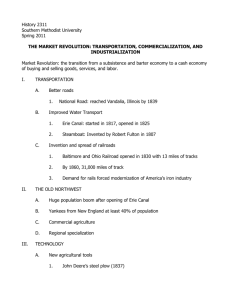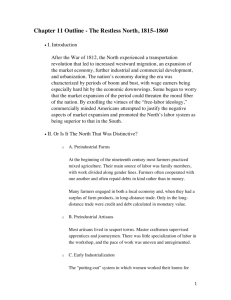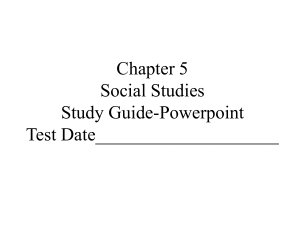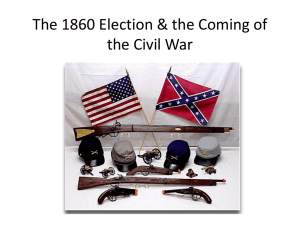CL US I Chapter 11 Notes
advertisement
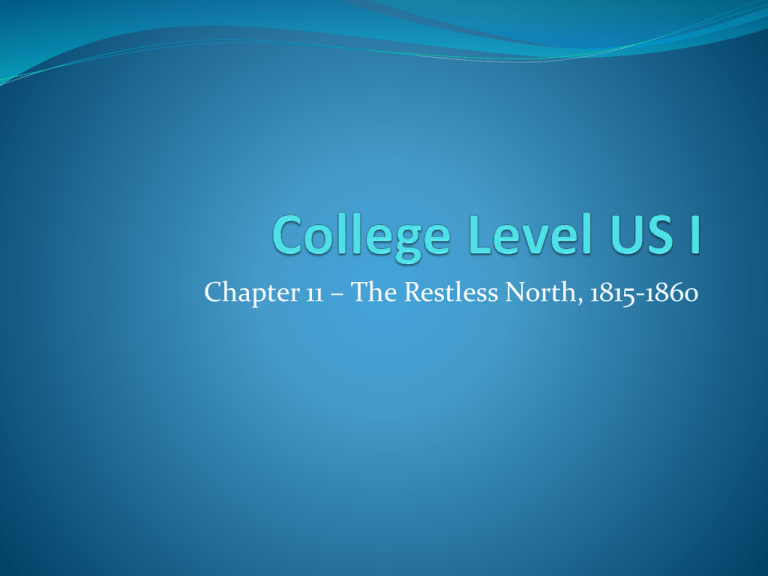
Chapter 11 – The Restless North, 1815-1860 I. Introduction After the War of 1812, the North experienced a transportation revolution that led to increased westward migration, an expansion of the market economy, further industrial and commercial development, and urbanization. The nation’s economy during the era was characterized by periods of boom and bust, with wage earners being especially hard hit by the economic downswings. Some began to worry that the market expansion of the period could threaten the moral fiber of the nation. By extolling the virtues of the “free-labor ideology,” commercially minded Americans attempted to justify the negative aspects of market expansion and promoted the North’s labor system as being superior to that in the South. II. Or Is It The North That Was Distinctive? A. Preindustrial Farms At the beginning of the nineteenth century most farmers practiced mixed agriculture. Their main source of labor was family members, with work divided along gender lines. Farmers often cooperated with one another and often repaid debts in kind rather than in money. Many farmers engaged in both a local economy and, when they had a surplus of farm products, in long-distance trade. Only in the long-distance trade were credit and debt calculated in monetary value. II. Or Is It The North That Was Distinctive? B. Preindustrial Artisans Most artisans lived in seaport towns. Master craftsmen supervised apprentices and journeymen. There was little specialization of labor in the workshop, and the pace of work was uneven and unregimented. C. Early Industrialization The “putting-out” system in which women worked their looms for wages rather than primarily for their families, developed in the Northeast in the late eighteenth and early nineteenth centuries. Early factories emerged in tandem with the putting-out system. Although separating flax fibers from their woody base could be arduous work, flax-scutching bees—much like corn-husking bees—brought together neighbors for frivolity as well as work. III. The Transportation Revolution A. Roads The lack of a road system slowed the movement of troops and supplies during the War of 1812. As a result, for defense purposes, the war prompted renewed interest in building roads. B. Steamboats In 1807, Robert Fulton’s Clermont demonstrated the feasibility of using steam engines to power boats. III. The Transportation Revolution C. Canals Prior to 1817, small canals were built by private companies to transport goods and produce. The success of the Erie Canal sparked an explosion of canal construction. By 1840, more than 3,000 miles of canals had been built. High construction costs and a constricting economy caused an end to the canal era in the 1850s. D. Railroads Railroad development started in the 1830s and quickly came to compete with canals. By 1860, there were more than 60,000 miles of track, most of it in the North. Major Roads, Canals, and Railroads, 1850 III. The Transportation Revolution E. Government Promotion of Internal Improvements Northern state and local governments and private investors spent far more on internal improvements than did southerners. The slaveholding elite in the South continued to invest most of their money in land and slaves. III. The Transportation Revolution F. Regional Connections While internal improvements in the South were local in nature, internal improvements in the North established economic, cultural, and political links between the Northeast and Northwest. By 1852 over 23,000 miles of telegraph lines made it possible to coordinate market conditions, production, and supply across great distances. III. The Transportation Revolution G. Ambivalence Toward Progress While many people welcomed the new opportunities afforded them by internal improvements, others viewed the consequences of such improvements in a negative light. IV. Factories and Industrialization A. Factory Work The hierarchical control structure and formal rules of the factory system worked to reduce factory workers’ sense of autonomy. Americans contributed new manufacturing ideas, such as machine-made interchangeable parts and machine-tools. The American System reduced the time and skill involved in manufacturing and permitted mass production at low cost. IV. Factories and Industrialization B. Textile Mills After 1815, the New England cotton mills developed into modern factories. To find the people necessary to staff their mills, many managers adopted the Waltham Plan. Inducements were offered to New England farm daughters, and the managers accepted responsibility for their living conditions. Many teenage girls became factory workers because they wanted some degree of independence. The Rhode Island Plan, in which mills hired entire families, was more common than the Waltham Plan. A young mill girl at Waltham or Lowell, probably in the late 1840s. Her swollen and rough hands suggest that she worked, as did most twelve- and thirteen-year-olds, as a warper, straightening the strands of cotton or wool as they entered the looms. IV. Factories and Industrialization C. Labor Protests In the hard times from 1837 to 1843, the race for profits led to a deterioration of working conditions in the Lowell mills. Poor working conditions gave rise to organized protests and a concerted effort to lobby the government for labor laws. As fewer New England daughters entered the mills, they were replaced by Irish immigrant women in the 1850s. Some workers also formed labor parties and became active in reform politics. IV. Factories and Industrialization D. Labor Unions In response to changes in the workplace, some workers began to organize in an attempt to regain control of their work and their lives. Although workers enjoyed some successes, such as overcoming the threat of conspiracy charges, permanent labor organizations proved difficult to maintain. V. Consumption and Commercialization A. The Garment Industry Advances in the textile industry gave birth to the ready-made clothing industry, which had a profound effect on what Americans wore. Initially, the greatest demand for ready-made clothes was in the cotton South where planters bought such shoes and garments for slaves. V. Consumption and Commercialization B. Specialization of Commerce Beginning with the cotton industry, commerce expanded in conjunction with manufacturing. Commercial specialization transformed brokers into powerful components of the market economy. In big cities, some traders became virtual merchant princes. Improvements in transportation and the growth of towns led even small-town merchants to specialize. V. Consumption and Commercialization C. Commercial Farming In response to problems such as soil erosion and competition from western farmers, many in the Northeast either moved west or went to work in factories. Those who stayed on their farms, however, successfully adapted to changing methods of agriculture. D. Farm Women’s Changing Labor The commercialization of agriculture meant that women’s earnings became essential for the survival of the family farm. V. Consumption and Commercialization E. Rural Communities The social life of farm men and women continued to consist of trips to the market and meeting at church and at such events as barn raisings and husking bees. However, farmers became more likely to settle debts in dollars rather than in kind. F. Cycles of Boom and Bust Economic growth proved uneven. Periods of contraction and deflation often countered times of prosperity. The new market economy was a direct cause of boom-and-bust cycles. As the nation experienced a serious financial contraction in 1857, prices fell as business languished. But the availability of bargains did not compensate for widespread unemployment and falling wages. VI. Families in Flux A. The “Ideal” Family The family was idealized by middle-class Americans as a moral and cultural institution separated from the world of the workplace. Men were to provide for and protect the family, while women were to nurture and guard the family’s morality. This ideal of the family is known as the separate-sphere ideology or the cult of domesticity. As they strove to live according to new domestic ideals, middle-class families often relied on African American or immigrant servants, who sacrificed time with their own children in order to care for their employers’ children. VI. Families in Flux B. Shrinking Families The birthrate declined, partly because smaller families seemed more economical in the market economy. More Americans employed forms of contraception. If other means of birth control failed, abortion was also an option. VI. Families in Flux C. Women’s Paid Labor Women from working-class families worked to support their families. Many women from middle-class families viewed working in mills, department stores, or schools as temporary occupations before marriage. VII. The Growth of Cities A. Urban Boom During the period from 1820 to 1860 there was rapid urbanization, with most of the growth taking place in the Northeast and Midwest. Cities not only experienced population growth but geographic expansion as well. Mass transit made city expansion possible. Major American Cities in 1820 and 1860. The number of Americans who lived in cities increased rapidly between 1820 and 1860, and the number of large cities grew as well. In 1820, only New York City had a population exceeding 100,000; forty years later, eight more cities had surpassed that level. VII. The Growth of Cities B. Market-Related Development Nineteenth-century cities began serving as transportation hubs, commercial centers, and manufacturing sites. In the South, most cities were seaports; in the North, many formed inland because of transportation improvements. The rapid growth of cities led to sanitation and waste disposal problems. Sanitation and other services depended on the ability of residents to pay. City governments were eventually forced to take over supplying residents with clean water. VII. The Growth of Cities C. Extremes of Wealth The gap between rich and poor widened in the United States during the first half of the nineteenth century. Growing cities did not have adequate housing for their residents, and many of the urban poor lived in slums. The urban elite thrived in this period, often using inherited wealth to increase their power and riches. A distinct middle class existed in urban America and enjoyed the fruits of the expanding market economy. VII. The Growth of Cities D. Immigration Some 5 million immigrants came to the United States between 1830 and 1860. Many, such as the Irish and some Germans, were escaping starvation and despair in their native countries, while others were political refugees. Many immigrants grew dissatisfied with life in the United States, and thousands of them returned home. By 1860, most immigrants gravitated toward cities. Major Sources of Immigration to the United States, 1831–1860. Most immigrants came from two areas: Great Britain, of which Ireland was a part, and the German states. These two areas sent more immigrants between 1830 and 1860 than the inhabitants of the United States enumerated at the first census in 1790. By 1860, 15 percent of the white population was of foreign birth. Visible signs of urban poverty in the 1850s were the homeless and orphaned children, most of them immigrants, who wandered the streets of New York City. The Home for the Friendless Orphanage, at 29th Street and Madison Avenue, provided shelter for some of the orphan girls. VII. The Growth of Cities E. Ethnic Tensions Non-British, non-European, non-Protestant people were often described in negative, racial terms by the white, Anglo-Saxon majority. There was also widespread anti-Catholicism and anti-Irish sentiment. German immigrants generally fared better than the Irish. Immigrants often clustered together in ethnic enclaves. VII. The Growth of Cities F. People of Color The free black population in the North grew to some 250,000 by 1860. Black churches and preachers helped forge a sense of community, which helped free blacks cope with their hardships. In the North, African Americans faced exclusion from or segregation in public places. They also suffered hiring and wage discrimination. In cities African Americans became targets of urban violence. Immigrants often considered themselves superior to African Americans, fueling racial tensions. Here, a German immigrant demonstrates his sense of superiority even as he relies on an African American laborer for directions. Domestic servants await their fate at a hiring office. Because servants resided with their employers, concerns about honesty often topped an employer’s list of priorities for a suitable servant. VII. The Growth of Cities G. Urban Culture The growth of cities encouraged people to form private clubs and associations, while growing neighborhoods created distinctive youth cultures. Recreation and sports in the city became a commodity to be purchased. The theater provided an important source of enjoyment in the urban environment. Minstrel shows were particularly popular, but they furthered racial divisions because of the stereotypical manner in which blacks were portrayed. VII. The Growth of Cities H. The Penny Press The penny press emerged in the 1830s as a new form of urban journalism. In contrast to the established press, the penny press was non-partisan and covered a wider variety of news and human interest stories. Its cheap price enabled working-class people to buy newspapers regularly. VII. The Growth of Cities I.Cities as Symbols of Progress Many northerners saw cities as a symbol of progress and as representing the moral triumph of civilization over savagery. At the same time, others saw cities as a symbol of decay and moral decline. Middle-class reformers attempted to purify cities of their disease and vice and emphasized that upward mobility was possible if one worked hard and lived a virtuous life. By the 1850s many northerners had accepted this free-labor ideology as the antithesis of the South’s slave-based economic system.
